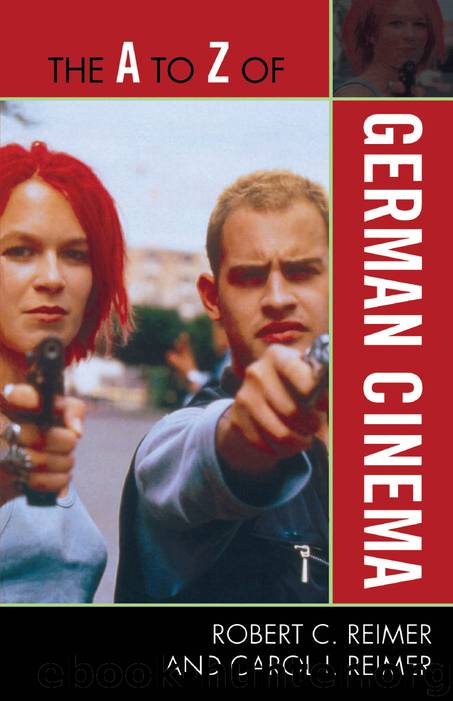The A to Z of German Cinema by Robert C. Reimer & Carol J. Reimer

Author:Robert C. Reimer & Carol J. Reimer
Language: eng
Format: epub
Publisher: Scarecrow Press
Published: 2008-04-14T16:00:00+00:00
– P –
PABST, GEORG WILHELM (1885–1967). Although his directing career spanned four decades, from the Weimar Republic to the postwar years, and his works include some of the most popular and critically acclaimed films of their day, Georg Wilhelm Pabst never gained the auteur reputation of many of his contemporaries. This lack of recognition may be due in part to his large output, which makes it difficult to find a unifying or auteur principle at work in all his films, particularly as they occurred over so many years. In part, it may be due to his inclination to make his films timely, thus relating them to contemporary sociopolitical problems rather than to his personal vision. Finally, there may be reluctance to grant Pabst his due for historical–political reasons. He returned to Austria after the Nazis had gained power there and made films for the National Socialists when he realized he could not return to the United States, thus opening himself up to charges of opportunism. Particularly troubling to some film historians is the fact that the two films he made for the Nazis, although escapist entertainment, nonetheless served the government’s propaganda machine.
Pabst’s most acclaimed films were made during the silent era. One of his earliest features, Die freudlose Gasse (The Joyless Street, 1925), introduced the legendary Greta Garbo to an international audience. The film exposes the growing misery of Vienna’s middle class during the inflationary period at the hands of an exploitative black-marketeering elite. Die freudlose Gasse was one of a series of left-leaning films made in the Weimar Republic that documented for viewers the misery they were enduring outside the theater. The themes of sex, money, and power dominate in Pabst’s work, which led authorities to censor his great silent films, particularly when shown in America. The director’s Die Büchse der Pandora (Pandora’s Box, 1929) made Louise Brooks an icon of German silent film. The film personifies sexuality in its main character, Lulu, German expressionist playwright Frank Wedekind’s free-spirited and sensual creation, a femme fatale who destroys the men who love her until she herself is killed by Jack the Ripper. The success of Die Büchse der Pandora led to further collaboration between Pabst and Brooks. Their second film, Das Tagebuch einer Verlorenen (Diary of a Lost Girl, 1929), contains themes of rape, seduction, and unwed motherhood played out in the milieu of country home, reform school, and brothel.
Pabst’s early sound films before the Nazi takeover reveal his wide range of social commitments. Westfront 1918 (Comrades of 1918, 1930) is an antiwar epic that many consider more effective than Lewis Milestone’s classic All Quiet on the Western Front (1930). Both films were despised by the National Socialists, who upon their release in 1930 disrupted showings through acts of hooliganism and finally suppressed them once Adolf Hitler took power. Westfront 1918 was one of five Pabst films to make a list of 100 greatest German films ever, voted on by film critics, directors, and historians.
Pabst’s version of Bertolt Brecht’s play
Download
This site does not store any files on its server. We only index and link to content provided by other sites. Please contact the content providers to delete copyright contents if any and email us, we'll remove relevant links or contents immediately.
Call Me by Your Name by André Aciman(20371)
Ready Player One by Cline Ernest(14520)
How to Be a Bawse: A Guide to Conquering Life by Lilly Singh(7382)
Wiseguy by Nicholas Pileggi(5668)
The Kite Runner by Khaled Hosseini(5081)
On Writing A Memoir of the Craft by Stephen King(4863)
Audition by Ryu Murakami(4840)
The Crown by Robert Lacey(4722)
Call me by your name by Andre Aciman(4610)
Gerald's Game by Stephen King(4570)
Harry Potter and the Cursed Child: The Journey by Harry Potter Theatrical Productions(4438)
Dialogue by Robert McKee(4321)
The Perils of Being Moderately Famous by Soha Ali Khan(4169)
Dynamic Alignment Through Imagery by Eric Franklin(4115)
Apollo 8 by Jeffrey Kluger(3635)
The Inner Game of Tennis by W. Timothy Gallwey(3575)
Seriously... I'm Kidding by Ellen DeGeneres(3574)
How to be Champion: My Autobiography by Sarah Millican(3554)
Darker by E L James(3474)
